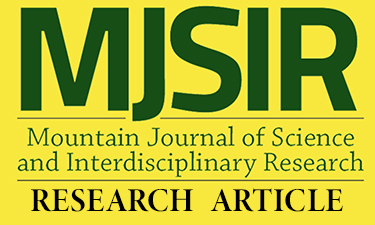Betel Nut Consumption: Exploring Perceptions of Young Farmers in Natubleng, Buguias, Benguet, Philippines
Main Article Content
Abstract
This ethnographic study explored the perspectives of young farmers regarding betel nut chewing. This study examines the perspectives of young farmers on betel nut chewing and explores the social factors that motivate this practice. The research reveals that betel nut chewing is not simply a habit for pleasure rather it is a habit to manifest shared beliefs and perceptions. It also serves as a means of asserting one’s social identity based on the socially constructed meaning they attach to it. The habit is revealed to be a representation of masculinity among young farmers. Moreover, betel nut chewing becomes a fulcrum of socialization among young farmers. However, the study also reveals that betel nut chewing causes some issues, leading young farmers to adopt measures such as proper oral hygiene and the use of star anise (Illicium verum) to mask bad smells. The research concludes that betel nut chewing is a complex practice driven by the beliefs and social implications attached into the habit.
Article Details
References
Anand, R., Dhingra, C., Prasad, S., & Menon, I. (2014). Betel nut chewing and its deleterious effects on oral cavity. J Cancer Res Ther., 10(3): 499-505. https://doi.org/10.4103/0973-1482.137958
Batani, R.S. (2016). Toknang. “Humor that Bites” Understanding the Subculture of Young Farmers. Benguet State University Research Journal, 76: 67-82. http://portal.bsu.edu.ph:8083/index.php/BRJ/article/view/8/231
Bhandare, A.M., Kshirsagar, A.D., Vyawahare, N.S., Hadambar, A.A., & Thorve, V.S. (2010). Potential Analgesics, anti-inflammatory and antioxidant activities of hydroalcoholic extract of Areca Catechu Nut. Food Chem Toxicol., 48(12): 3412-7. https://doi.org/10.1016/j.fct.2010.09.013
Bulwayan, R.B., Balocnit, D.A., & Sannadan, J.G.M. (2023). Piper Betel and Areca Nut: Interfacing Cultural, Communication and Ethno-therapeutic Knowledge as Reflected in the Kalinga Epic, the Ullalim. International Journal of English Literature and Social Sciences, 8(3): 385-404. https://ijels.com/upload_document/issue_files/60IJELS-106202312-PiperBetel.pdf
Chauhan, E.S., Aishwarya, J., Singh, A., & Tiwari, A. (2016). A Review: Nutraceuticals Properties of Piper Betel (Paan). American Journal of Phytomedicine and Clinical Therapeutics, 2: 028-041. https://www.afdpharma.com/userfiles/nutraceutical-properties-of-piper-betel.pdf
Chen, X., He, Y., & Deng, Y. (2021). Chemical Composition, Pharmacological and Toxicological Effects of Betel Nut. Evidence-based Complementary and Alternative Medicine. https://doi.org.10.1155/2021/1808081
Chowdbury, R.B.M.A. (2021). What is Coping Theory. PositivePsychology. https://positivepsychology.com/coping-theory
Connell, R.W. (1987). Gender and power: Society, the person and sexual politics. Stanford University Press.
Conelly, W.T. (1996). Agricultural Intensification in a Philippine Frontier Community: Impact on Labor Efficiency and Farm Diversity. In: Bates, D.G., Lees, S.H. (eds) Case Studies in Human Ecology. Springer, Boston, MA. https://doi.org/10.1007/978-14757-9584-4_13
Garg, A., Chaturvedi, P., & Gupta, P.C. (2014). A Review of the Systemic Adverse Effects of Arcea Nut or Betel Nut. Indian Journal of Medical and Pediatric Oncology, 35(1): 3-9. https://www.thieme-connect.de/products/ejournals/abstract/10.4103/0971-5851.133702
Hassanpour, S., Mahersis, N., & Eshratkhah, B. (2011). Plants and Secondary Metabolites (Tannins): A Review. International Journal of Forest, Soil and Erosion, 1(1): 47-53. https://www.researchgate.net/publication/216069956_Plants_and_secondary_metabolites_Tannins_A_Review
Hogg, M.A. (2007). Uncertainty-identity theory. In M.P. Zanna (Ed.), Advances in experimental social psychology, Vol. 39, pp. 69–126. Elsevier Academic Press. https://doi.org/10.1016/S00652601(06)39002-8
Howden G.F. (1984). The cariostatic effect of betel nut chewing. Papua New Guinea Medical Journal, 27(3-4): 123-131. https://pubmed.ncbi.nlm.nih.gov/6598935/
Hussain, A., Zaheer, S., & Shafique, K. (2018). Reasons for betel quid chewing amongst dependent and non-dependent betel quid chewing adolescents: a school-based cross-sectional survey. Subst Abuse Treat Prev Policy,13(1). https://doi.org/10.1186/s13011-018-0154-5
Lavapie-Gonzales, F.A. (2017). Betel Nut Chewing among the Ibaloy of Benguet. Philippine Journal of Linguistics, 48(2), 27-42.
Lupton, D. (2000). The Social Construction of Medicine and the Body. In Handbook of Social Studies and Medicine. https://doi.org/10.4135/9781848608412
McVittie, C., Hepworth, J., & Goodall, K. (2017). Masculinities and Health. In The Psychology of Gender and Health. https://doi.org/10.1016/B978-0-12-203864-2.00004-3
Mehan, H. (1981). Social Constructivism in Psychology and Sociology. University of California, San Diego. Department of Sociology.
Meteoblue. (2023). Simulated Historical Climate and Weather data for Buguias. https://www.meteo blue.com/en/weather/historyclimate/climatemodelled/buguias_philippines_1723211#
Mckay, D., & Perez, P.L. (2017). Plastic Masculinity: How Everyday Objects on Plastic Suggest Men could be Otherwise. Journal of Material Culture, 23(2). https://doi.org/10.1177/1359183517742424
Moe, T., Boonmongkoon, P., Lin, C.F., & Guadamuz, T. (2015). Yauk gyar mann yin (Be a man): Masculinity and Betel Quid chewing among men in Mandalay, Myanmar. Cult Health Sex, 18(2): 129–142. https://doi.org/10.1080%2F13691058.2015.1055305
Nelson, B.S., & Heischober, B. (1999). Betel Nut: A Common Drug used by Naturalized Citizens from India, Far East Asia and the South Pacific Islands. Ann Emerg Med., 34(2): 238-43. https://doi.org/10.1016/s0196-0644(99)70239-8
Norton, S.A. (1998). Betel: Consumption and Consequences. J Am Acad Dermatol., 38(1):81-8. https://doi.org/10.1016/s0190-9622(98)705432
Occupation Safety and Health Administration.(n.d.). Green Tobacco Sickness. https://www.osha.gov/green-tobacco-sickness
Senn, M. Baiwog, F, Winmai, J., Mueller, I., Rogerson, S., & Senn, N. (2009). Betel nut chewing during pregnancy, Madang province, Papua New Guinea. Drug and Alcohol Dependence, 105(1-2): 126-131. https://doi.org/10.1016/j.drugalcdep.2009.06.021
Shah, G., Cahturvedi, P., & Vaishampayan, S. (2012). Areca Nut as an emerging Etymology of Oral Cancers in India. Indian Journal of Medical and Pediatric Oncology, 33(2): 71–79. https://doi.org/10.4103%2F0971-5851.99726
Shafique, K., Mirza, S.S., Vart, P., Memon, A.R., Arain, M.I., Tareen, M.F., & Haq, Z.U. (2012). Areca Nut Chewing And Systematic Inflammation: Evidence Of A Common Pathway For Systemic Diseases. Journal of Inflammation, 9(1):22. https://doi.org/10.1186/1476-9255-922
Staples, G.W., & Bevacqua, R.F. (2006). Areca Catechu (Betel nut palm). Species Profiles for Pacific Island Agroforestry. https://www.researchgate.net/publication/228662997_Areca_catechu _betel_nut_palm
Strickland, S.S. (2002). Anthropological Perspectives on Use of the Areca Nut. Addiction Biology, 7(1): 85-97. https://doi.org/10.1080/13556210120091446
Sulkunen, P. (1982). Society made visible on the cultural sociology of Pierre Bourieu. Acta Sociologica, 25(2): 103-115. https://www.jstor.org/stable/4194391
Talmage-Bowers, M. (2018). How Dangerous is Betel Nut? Healthline. https://www.healthline.com/health/betel-nut-dangers
Wanderein. (2019). Moma 101 Learning about “NgaNga” (Betel Nut) from Young Ifugao. https://wanderein.com/moma-101-learning-aboutnganga-from-a-young-ifugao-in-batad
Warnakulasuriya, S., Chaturvedi, P., & Gupta,P.C. (2015). Addictive Behaviours need to include Areca Nut Use. Addiction, 110(9): 1533. https://doi.org/10.1111/add.13006
World Health Organization. (2012). New Report reveals High relevance of Betel, Tobacco Chewing in Western Pacific. https://www.who.int/westernpacific/news/item/23-03-2012-new-reportreveals-high-prevalence-of-betel-tobaccochewing-in-western-pacific

